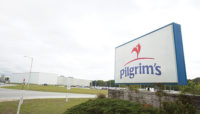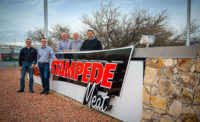When it comes to processing chicken, the folks at the Lufkin, TX, facility of Pilgrim’s Pride have positioned themselves so perfectly in tune to the marketplace that it seems as though they were “naturals” at it — born to manufacture chicken and do it well.
Now, the company has selected a prime location to meet two up-and-coming industry trends, with the Lufkin plant revamped and poised to be a key producer of net-weight and enhanced chicken products.
Seeing the potential that both net-weight and enhanced chicken held three years ago, Pilgrim’s Pride decided to seize the opportunity and make a commitment to these products with substantial facility upgrades in Lufkin.
That overhaul, which remarkably took Lufkin employees only nine days to complete, spurred a chain of events that steeled the plant’s current place as a highly efficient processor of all-natural and net-weight chicken.
The net change
The road to Lufkin’s prominent place in the company’s plans had a few bumps, but the trip is a perfect example of the old adage, “If you want something done right, you have to do it yourself.”
When the Lufkin plant’s management team explored overhauling the facility, it was given an extraordinary proposal, says Cecil Jackson, complex manager for Pilgrim’s Pride’s Lufkin/Nacogdoches complex.
“The engineers and experts told us that the only way to make this process work was to build a building that took up the whole parking lot [across the street], run the product overhead in a tunnel and do the process over there, because it couldn’t be done [in the current facility],” he says. “And we were too hard-headed to understand that.”
So the entire Lufkin team went back to the drawing board — their own drawing board.
“The layout was done by our team, putting it together and really just working all of the different angles and blueprints,” Jackson continues. “[Employees] designed it and did the install. That really was key, because they had an ownership of the process, and when we got through, they had an absolute understanding of how the process works.”
Dan Emery, director of marketing for the company, says that the successful conversion of the Lufkin plant turned out to be a nice reflection of the company’s resilience and ability.
“I was about as proud of these guys as any for what they accomplished, because this was one of those things that the guy said was basically impossible, but they made it happen,” Emery explains. “They scratched their heads enough to figure it out, and they spent a lot less money than what the experts said it was going to cost.
“What they said it was going to cost never would have worked. That’s what I love about this company: ‘No’ is not particularly an option. Getting it figured out, whatever it takes, is kind of what we do.”
Lufkin management opened the floor to everyone, incorporating into the grand plan the hands-on experience from dozens of employees who had worked in the plant for decades. And each time the plant needs updating or modification, the management team knows who to turn to first.
“When we sit down, break out blueprints and say, ‘This is what we’re thinking about changing,’ rather than getting some engineer, [who doesn’t know the plant] as far as process flow and operations, we’ll make copies of that blueprint and give it to everyone out there and say, ‘Tell us where we’re goofing this up,’” Jackson says. “And they’ll come back and tell you in a minute.”
That kind of investment in its own people has helped the company, as Jackson boasts of scores of workers who have been in the Lufkin plant for 20 to 25 years or more and the plant’s record of promoting from within. One example is plant manager John Davidson, who started nearly 18 years ago as a quality assurance technician at the Lufkin plant and worked his way up through the ranks to his current position.
Davidson was among those charged with changing over the plant and says that involving the entire team from the start allowed everyone to be on the same page, ensuring a smooth transition.
“The amount of equipment we pulled out of the plant and the things that we put back in, to turn around and crank that thing up and run it — and run it as well as it did — that’s just a pat on everybody’s back,” Davidson adds. “It wasn’t just one person, it was the whole team.”
Perfecting the process
Teamwork is still part of the Lufkin plant’s daily mantra. In fact, it is still evident on the plant floor as well as in the production results. Teamwork allows the Lufkin plant to process 1.5 million birds per week efficiently, giving the company a possible edge in producing net-weight products.
“The guys have gotten sharper in managing the [net-weight] program,” says Bob Palm, senior vice president, Case Ready Regional Operations. “Of course, the key to net weight is that you don’t want to give away the farm either, and that’s why a lot of people shy away from that.”
But Pilgrim’s Pride uses the efficiency and longevity of its employees to its advantage in this realm, giving it a leg up in a key marketplace, Jackson says. He suggests that the team that Pilgrim’s has assembled in Lufkin is the reason that the company performs so well at producing net-weight items.
“Our overpack is extremely low,” Jackson adds. “The few competitors we have out there, typically, … because they haven’t been successful in managing overpack, they’ve shied away from some of the business, and they don’t want to get into it any deeper.
“Our engineering and our day-to-day planning have really made this thing successful to where we can do it at a low cost. But those barriers to entry in the day-to-day operational costs have really keep competitors out of doing it.”
Pilgrim’s Pride succeeds in net-weight products because it realizes that the process can be a cost burden if not efficiently monitored and operated. Overpack — even a low amount of it — costs the company money, as does purchasing and installing the additional equipment needed to run net-weight. But the potential, based on the benefits for retailers and consumers, is substantial if those costs are controlled.
“[Net weight is] also an added value,” Jackson counters. “Just like taking raw chicken, batter-breading it, and having it at the store IQF where you just throw it in the microwave, is a value-added process, the net weight is a value-added process for our retailers.”
Retailers get improved record-keeping and product and information flow because net-weight packages are in predetermined unit sizes, and the consumers even benefit slightly since they typically do get a small amount of additional chicken per package.
These are things that position Pilgrim’s to attract consumers and retailers to the net-weight concept, putting the company in a position that Emery predicts can be the key to future growth and profits.
“I think it’s the future of the way that meat processing is going to go, as scary as that is to the beef and pork people, because these retailers really want to be able to measure a unit,” he says. “Until they can measure a unit, they can’t use computers and those types of things to do automatic replenishment.”
Net-weight production at the Lufkin plant is a speedy process that begins once the chicken pieces are fully processed and ready for packing. Those pieces zip along a fast-moving conveyor toward the net-weight scales. Along the way, they are distributed evenly on the conveyor to feed the scales at a consistent rate.
The scale automatically weighs each piece as it passes through and records it for portioning purposes. It then shuttles the piece to one of several hoppers, based on the weight needed in that hopper to complete a full portion. These processes happen in a matter of seconds. If the packaging calls for two pounds of drumsticks, the automatic scale will automatically and efficiently calculate the best combination of drumsticks in each package to minimize overpack as much as possible.
Once each hopper has met the desired weigh limit, the bottom opens, dropping the portion a few inches onto a ribbed conveyor that keeps each “set” of chicken pieces together in its group during its travel time to the packaging area.
A natural extension
The changes made in the Lufkin plant nearly three years ago also opened the door to a quickly emerging market of another variety — all-natural chicken. Pilgrim’s Pride recently rolled out its line of all-natural chicken, another project that the Lufkin plant was perfectly positioned to take upon its shoulders.
Nothing really changed on the plant floor as far as the processes went, Jackson explains, to make the chicken all-natural, because the marination equipment was already in place.
“The real key was coming up with the right formulation to have the natural flavor and be able to retain it in the product,” Jackson says. “That, in and of itself, has been a real science.”
Yet, the challenge was worth the effort, as enhanced products were a great addition to the Pilgrim’s Pride line, Emery explains. Enhanced chicken provides a much easier product for the ever-on-the-go or constantly distracted consumer to cook without drying out, making the quality of the product something the company wanted it its lineup.
“Product gets dry, it gets abused, and enhanced product just performs better in cooking, so there’s a multitude of reasons why it makes sense to do it,” he adds. “Breast product is even more sensitive to being dried out than leg-meat product, and obviously the trend is more and more toward breast product.”
Aside from the ease of use and the taste improvements over non-enhanced chicken, Pilgrim’s Pride notes that the product also has several benefits to grab the attention of consumers, from the fact that the product can be labeled “A Grade” chicken and is a certified, heart-healthy product as well.
Palm concludes that he believes the changes in the Lufkin plant, which already serves about one-third of the Wal-Mart stores in the nation, have it in a great spot to meet future goals.
“I think [these offerings] will allow us to open some more doors,” Palm says. “Our company, as far as when case-ready is concerned, wants to own the Southwest and certainly Texas. This is just going to be another step for us in the right direction toward establishing ourselves even more in this part of the country.” NP




Report Abusive Comment